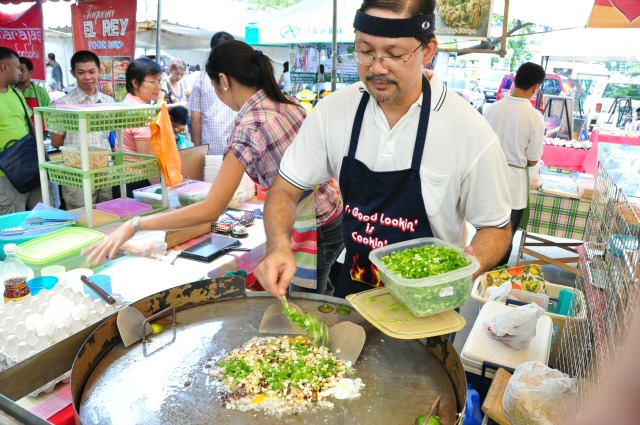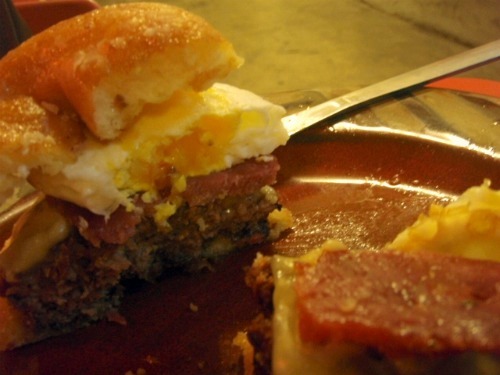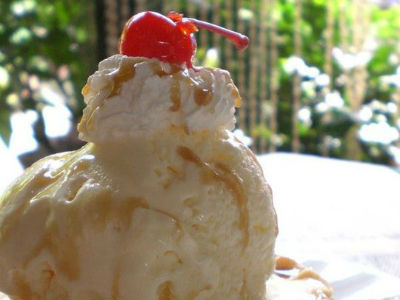Filtered By: Lifestyle
Lifestyle
The Year in Yum, 2012: Filipino cuisine, #foodgram, and artisanal mania
By AMANDA LAGO, GMA NEWS
Both vegetarianism and bacon broke new ground and artisanal eats were almost as popular as fast food treats. 2012 has certainly been an interesting year for food and food lovers.
Several trends from 2011 carried over to 2012, while social media invaded even the dining table.
Let's take a look back, smack our lips, and remember the yummiest, the most memorable food moments of the year.
1. #foodgram it
2012 was certainly the year of the #foodgram, or Instagrammed photos of food shared by people on their social media platforms. People no longer just sit down and eat anymore. In this social media-driven world where popularity is gauged online through “likes” and people are compelled to chronicle and share every single moment of their everyday lives because it's become so darn easy, a meal is not a meal unless you Instagram it first.
Because of this, whipping out your smartphone or tablet and snapping a photo of the dish you are about to devour has become as big a part of mealtime as saying grace or washing hands. Thanks to the popular photo-sharing app and its readymade filters, anything can look delicious. And when your followers start doling out the “likes,” even the blandest meal can taste #instagood.
2. Pinoy food is US's “next big thing”
Our own cuisine has never been bigger in 2012. 83 Philippine restaurants made it to the shortlist for the “2012/2013 Miele Guide.” A book that lists the best restaurants and chefs in Asia. An English master chef at the Upper East Restaurant in Makati brought East and West together by crafting dishes such as Monggo Hummus and Sous Vide Tarragon Chicken with Laing.

Still, Filipino staple dish adobo was a fave with the Adobolympics 2012.
Heritage cooking techniques were revived and sustained both by indigenous people and restaurateurs. A US food critic even called Filipino food “the next big thing” in the States, which means that lola's lutong bahay is about to get the attention its always deserved.
3. Artisanal everything!
Despite the various word play puns you can get out of it, the easiest way to sell a food item in 2012 was to label it “artisanal” or handmade.
We had artisanal ice cream, artisanal breads, artisanal cheese to artisanal salt. Endless handmade and homemade goodies made it to the food markets and weekend food bazaars. The rise of artisanal food parallels the still-growing popularity of food markets—which shows that Filipinos are starting to develop a palette for fine crafted food loaded, not with preservatives, but with love.

4. Hooray for the Locavores
A portmanteu of “local” and “carnivore”, 2012 wasn't just about getting organic food anymore. Getting food that is grown and produced locally—at least for the locavores, whose ranks increased in 2012--was the food lover's chic du jour.
More and more people started being conscious of the origins of their food, and those who fell into the locavore label preferred locally sourced products because aside from being cheaper, they also support local communities.
Along with the popularity of Filipino and artisanal food, the growing locavore lifestyle shows that, this past year, there was a growing desire for simpler fare that reminds us of home.
5. Meatless Mondays and vegetarianism
It's not easy to advocate vegetarianism in a country where celebrations feel incomplete without a whole-roasted pig or calf, where animal intestines are grilled and sold on the street. And yet we saw relentless initiatives to promote veggie-eating to the carnivorous citizens of the Philippines.
In July, Rep. Teodoro Casiño filed a House Bill that requires schools to have “Meatless Mondays” and serve only vegetable dishes in canteens on the first day of the school week. More than that, the list of vegetarian-friendly restaurants grew ever longer.
It's hard to imagine a mostly-vegetarian Philippines, but this year, the once-tiny vegetarian movement seems to be gaining big momentum.
6. Everything's better with bacon (even cupcakes)
Championed by the team of breakout food blog Pepper.ph, and everyone else in the world who eats pork, this sinful but utterly heavenly breakfast staple has gone beyond the almusal table, and into its comfortable home between the Double Down and the Baconator.
This year, bacon cupcakes (ala Max's products in American TV show “Two Broke Girls), and bacon ice cream made it to the food markets, along with what is perhaps an even more unhealthy (yes, it's possible) and more delicious (again, entirely possible) incarnation of bacon: a treat of deep-fried pork jowls called. . .bagwang (bagnet + bawang, get it?).
7. Want a burger with your burger?
After the Krispy Kreme burger from Offbeat Cafe and KFC's Double Down burger burst onto the scene last year, other eateries rose to the challenge. Jollibee came up with the Hash Brown burger (two baked hash browns in place of buns) in late 2011 and has kept it on their menu ever since.

This year, burgers became pretty big newsmakers when McDonald's put Big 'n Tasty burgers on their menu (to mixed reactions) and KFC gave us their cheese top burger, which was accepted well by some but considered by most to be an epic fail and was even parodied on a U.S. Television show.
8. Magnum, Ghirardelli, and more ice cream
There's no question that ice cream is one of the pinoy's perennial favorites when it comes to dessert—its coolness is perfect for our warm weather, and the thick sweetness fits right into our palate.
This year, the cool concoction had Filipinos at its mercy first when it took on the form of the infamous Belgian-chocolate-dipped, it-girl-endorsed Magnum early in the year. The ice cream craze was sustained by various homemade ice cream brands that had luxurious-sounding flavors like sea salt caramel, earl grey tea, and Ghirardelli chocolate chip cookie.

Of course, nothing beats the neighborhood sari-sari store's one-peso ice candy or Manong's good old dirty ice cream, which will always be on the Pinoy foodies' radar.
9. Buffets will never die
Filipinos have an overwhelming ability to stuff themselves silly with food. It is this simple truth that has made the Kamayan/Saisaki/Dad's trio an eat-all-you-can institution.
This year though, the trifecta staple it faced tough competition from the grill-all-you-can Japanese restaurants like Sambokojin and Yakimix, as well as hotel buffets like Sofitel's Spiral which unveiled its new look after it was forced to renovate when it was immersed in Typhoon Pedring floods last year.
10. Cup 'o' milk tea (still)
While the milk tea trend really started in 2011, you could say it blew up in 2012 as milk tea shops proliferated across the metro and beyond, bearing names that almost overused the word "tea" to the point of abuse in an effort towards word play (Serenitea, Simplicitea, Universitea, Lovely Citea--what?).
Milk tea patrons don't seem to mind what their suki store is called--with milk tea's semblance of health (given the anti-oxidant properties of tea, though the sugar they put in probably makes up for it) and its creamy-tart taste, it remains unstoppable--at least for now.
Milk tea patrons don't seem to mind what their suki store is called--with milk tea's semblance of health (given the anti-oxidant properties of tea, though the sugar they put in probably makes up for it) and its creamy-tart taste, it remains unstoppable--at least for now.
11. Food markets galore
2011 saw the birth of countless food markets that are now institutions in the local dining scene. This year, food markets were alive as ever with the addition of Mezza Norte in UP-Ayala technohub, and Manda Centrale in Greenfield district. Now there's a food market for everyone in the metro so that whether you live in Quezon City or Alabang, there will be a food market nearby.

It's not just that new food markets came on the scene, it's also that their vendors have gained a big enough following that they are able to set up shop outside the smoky confines of the food markets they were discovered in. Manang's Chicken, for instance, or Mochiko, which both started out with stalls in the now-famous Mercato market, already have their own shops in malls and major eating areas.
12. Follow that food truck
The tail end of 2012 brought with it a new food trend that's got huge potential to become the next big thing: food trucks.
These restaurants on wheels have been trending in the US where foodies can track a truck down and follow them via social media. Food trucks take a page off the jollijeep playbook, those mobile packed lunch machines that park outside office buildings in Makati, Ortigas and other major business centers, to offer hungry employees affordable eats. Some of the food trucks have also been parked at the bigger food bazaars like Mercato, and the seasonal Distrito.
Recently, the same organizers of these food bazaars launched a food truck market: Cucina Andare. It was so well-received by the people who flocked to it, first for the novelty and then for the quality of the fare, that it looks like a sure thing for repeat business.
Cucina Andare's food truck bazaar may only run for the weekends of December but this is certainly not the last we'll hear of them. As one food truck owner put it in a "Saksi" report: "it's exciting because it's a new trend." -- KDM, GMA News
More Videos
Most Popular




